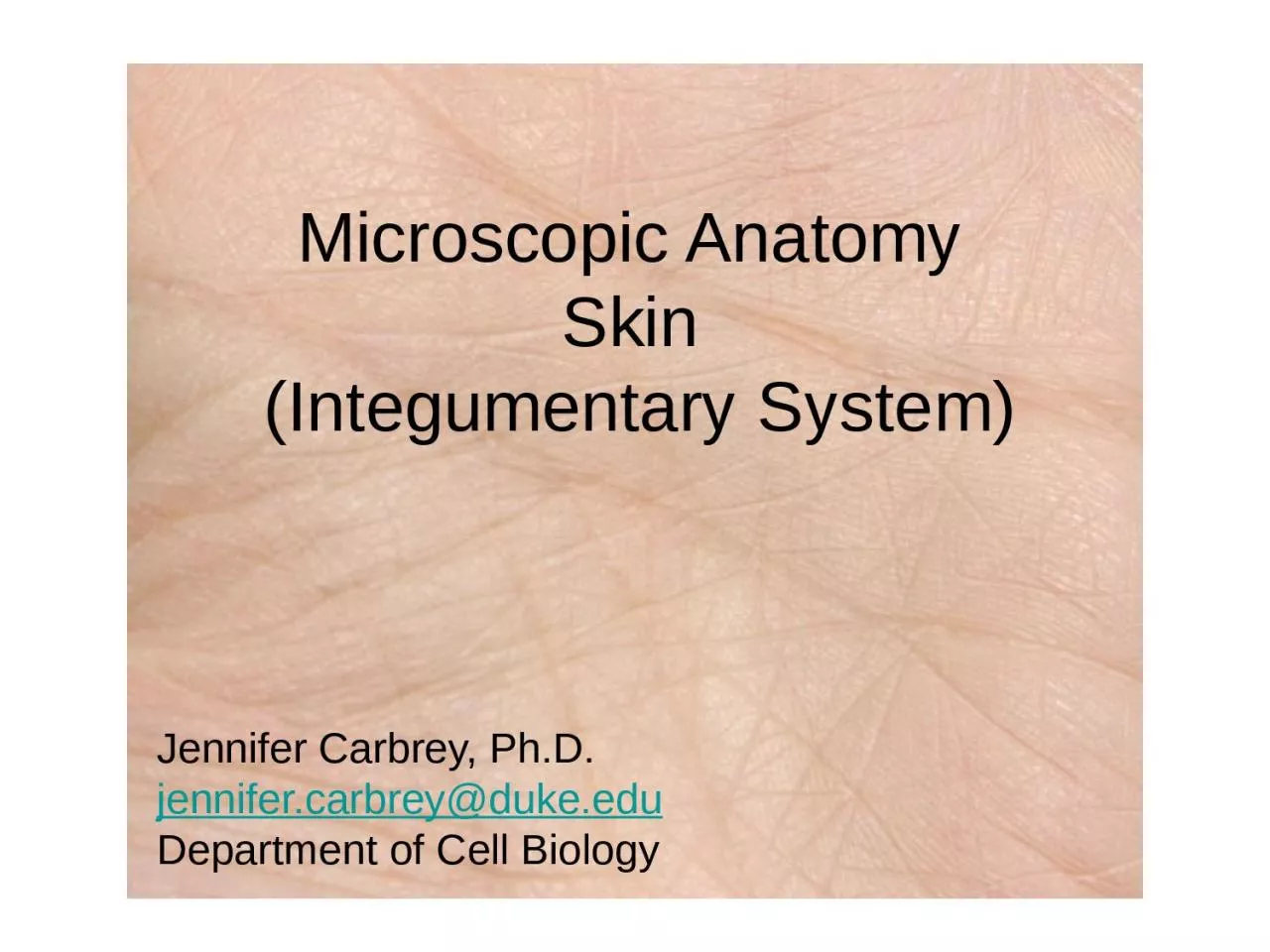

Integumentary System Jennifer Carbrey PhD jennifercarbreydukeedu Department of Cell Biology Goals To Describe the basic functions and types of skin the layers of the epidermis and how ID: 914773
Download Presentation The PPT/PDF document "Microscopic Anatomy Skin" is the property of its rightful owner. Permission is granted to download and print the materials on this web site for personal, non-commercial use only, and to display it on your personal computer provided you do not modify the materials and that you retain all copyright notices contained in the materials. By downloading content from our website, you accept the terms of this agreement.
Slide1
Microscopic Anatomy
Skin (Integumentary System)
Jennifer Carbrey, Ph.D.
jennifer.carbrey@duke.edu
Department of Cell Biology
Slide2Goals
To Describe:
the basic functions and types of skin
the layers of the epidermis and how
their characteristics contribute to skin function
the cell types of the epidermis and their role
in skin function
the tissues of the dermis and hypodermis and how
they contribute to skin function
the morphology and function of nerve endings
of the skin
the morphology and function of epidermal appendages
Slide3Functions of Skin – largest organ
Protection – barrier against UV light, mechanical force, dehydration, microbes
Sensation – temperature, pressure, pain, touch
Thermoregulation – insulated by hair and adipose tissue, sweat, changes in blood flow
Metabolism – storage of fat in adipose tissue, vitamin D production, milk production
Communication – blushing, apocrine sweat glands, raising of hairs (animals)
Slide4Layers of Skin
from ectoderm
from mesoderm
superficial fascia
Slide5thin skin
thick skin
Thin (hairy) skin vs Thick (hairless)
skin
Slide6Thin (hairy) skin
vs Thick (hairless)
Slide7Papillary ridges of thick skin
Epidermis
Dermis
Slide8Layers of Epidermis
Slide9Keratinocytes
Hair and Nails: hard keratins
Slide10Cell Junctions
Wei and Huang, Int Rev Cell Mol
Biol
, 2013; 306:187-221
Slide11Desmosomes
Slide12Desmosomes
also hemidesmosomes – integrins bind
ECM proteins
Slide13Epidermolysis Bullosa Simplex
mutation in keratin expressed
in basal cells of epidermis
another blistering disease
pemphigus – autoimmune
attack of desmosomal proteins
Slide14basal lamina
stratum basale
1 layer of cells
stratum spinosum
several layers
stratum granulosum
1-3 layers
stratum corneum
at least several layers
keratohyalin
granules
keratin filaments
lamellar
bodies
Layers of Epidermis
Slide15Layers of the epidermis
Slide16Keratinocytes in stratum spinosum
Slide17Detaching corneocytes
from stratum corneum
proteolysis of desmosomes
increases as pH decreases towards the surface
Slide18Other cells of epidermis:
Melanocyte in stratum basale
dendrites contain melanosomes filled with melanin
keratinocytes phagocytose exocytosed melanosomes or
dendrite tips
Slide19Melanocytes in stratum basale
Slide20Melanosomes in epidermis
skin color – melanin degradation rate
melanin distribution (which layers of epi)
type of melanin (eumelanin vs. pheomelanin)
Slide21Other cells of epidermis:
Langerhans’ cell in stratum spinosum
Slide22Langerhans’ cells in stratum spinosum
Slide23Skin Cancer
Basal Cell Carcinoma (basal cells) –
~150/100,000/year, <0.1% metastasize
Squamous Cell Carcinoma (keratinocytes) –
~40/100,000/year, ~1% metastasize
Malignant Melanoma (melanocytes) –
~17/100,000/year, ~15% metastasize
ABCD (asymmetry, border, color, diameter –
greater than 6 mm)
Slide24from Fell et al. (2014) Cell
, 157:1527-1534.Is tanning addictive?
Slide25Major Points
Skin has a keratinized stratified squamous epithelium (epidermis)
The layers of the epidermis are formed by keratinocytes in
various stages of differentiation
The keratin network and desmosome cell junctions of keratinocytes
are crucial for the mechanical strength of skin
Melanocytes provide keratinocytes with melanin to protect
from UV light
Langerhans’ cells are antigen-presenting cells of the epidermis
Slide26Layers of Skin
Slide27Dermal papillae
papillae contain
capillaries and
nerve endings
Slide28Dermal papillae
Slide29Layers of the dermis
Papillary layer
Reticular layer
collagen
determines
Langer’s lines
Slide30Blood Supply
Hypodermis
Dermis
Slide31Nerve Endings
temperature
pain
texture
stretch
vibration
m
ovement
of objects
a
gainst skin
Slide32Pacinian Corpuscles
Slide33Pacinian Corpuscles and Fingerprints
role of fingerprints – grip, sense of touch, or both?
made a sensor that mimics skin with fingerprints
fingerprints amplify vibrations (~100X) with
frequencies that best stimulate Pacinian corp.
important for perception of texture
surface needs to slide perpendicular to ridges
may be why elliptical patterns on fingertips
Slide34Meissner’s Corpuscles
Slide35Epidermal Appendages
Hair follicle
Apocrine
Sweat gland
Eccrine
Sweat gland
Sebaceous gland
Arrector pili
muscle
*also nails and
mammary glands
Slide36Hair Follicles
Slide37Arrector Pili Muscle
Slide38Hair Follicles
Slide39Hair Follicles
From Blanpain and Fuchs,
Nature Reviews
, 2009, 10:207-217
normal homeostasis
basal cells maintain epidermis
bulge cells maintain follicle
sebaceous gland stem cells too
wounding
stem cells of bulge are used to
repopulate epidermis, hair
follicles, and sebaceous glands
Slide40Epidermal Appendages
Hair follicle
Apocrine
Sweat gland
Eccrine
Sweat gland
Sebaceous gland
Arrector pili
muscle
*also nails and
mammary glands
Slide41Sebaceous glands
sebocytes secrete sebum: triglycerides,
fatty acids, waxes
Slide42Sebaceous gland
Slide43Epidermal Appendages
Hair follicle
Apocrine
Sweat gland
Eccrine
Sweat gland
Sebaceous gland
Arrector pili
muscle
*also nails and
mammary glands
Slide44Apocrine Sweat Glands
secrete a mixture of carbs, lipids,
protein and ammonia
secrete in response to emotional
stimuli
Slide45Apocrine Sweat Glands
simple cuboidal or columnar
secretory cells and
myoepithelial cells
ducts are str. cuboidal
ceruminous glands of ear
glands of Moll of eyelashes
Slide46Epidermal Appendages
Hair follicle
Apocrine
Sweat gland
Eccrine
Sweat gland
Sebaceous gland
Arrector pili
muscle
*also nails and
mammary glands
Slide47Eccrine Sweat Glands
secrete in response to increased
body temp or emotional stress
contains water, salt, lactate, urea, and
ammonia
Slide48Eccrine Sweat Glands
Slide49Hypodermis
Slide50Hypodermis
Dermis
Hypodermis
Slide51Changes in skin as we age
due to ROS, UV light, pollutants, loss of estrogenepidermis thins – turnover rate decreasesnumber of active melanocytes decreasessebum production decreasesloss of dermal papillae decrease in elastin and collagen turnoverdermis thinsfat in hypodermis decreases
Slide52Major Points
The dermis is a dense irregular connective tissue with dermal
papillae that contain capillaries
Many types of nerve endings are found in different parts of the
skin
Epidermal appendages are derived from the epidermis and include
hair follicles, apocrine sweat glands, eccrine sweat glands,
and sebaceous glands
The hypodermis is a fatty connective tissue layer that surrounds
some epidermal appendages